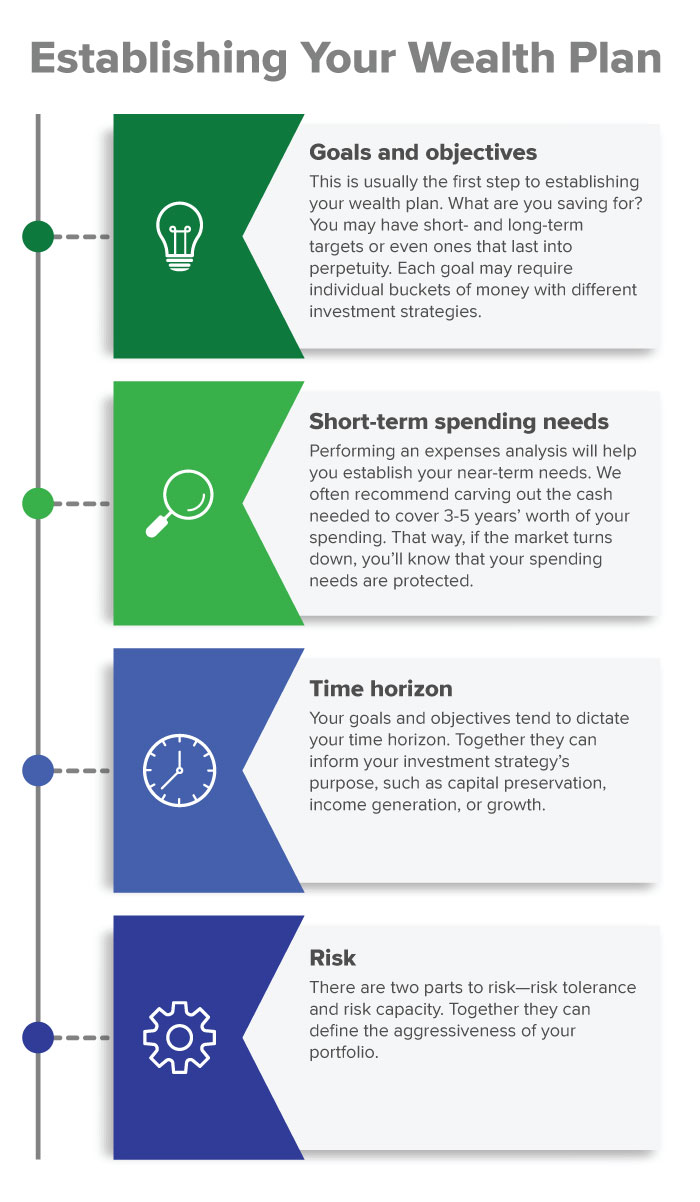Watching the market fall is tough, especially if you are near or in retirement—no ifs, ands, or buts about it. But a well-formed wealth plan—customized for your exact needs with the appropriate types and levels of risk—can help alleviate some of your fears. Because market drawdowns, even severe ones that may last for a while, should be expected and factored into your wealth strategy. Let us explain…
A wealth plan gets you where you want to go
What are your financial anxieties? Many worry that the next bear market could wipe them out or that spending on enjoyment now means they’ll let their heirs down by not providing for them later. Of course, everyone's financial situation and goals are different. That’s where a wealth plan comes into play.
A wealth plan is a roadmap to help you build, enjoy, protect, and transition your wealth. It looks at where you stand today and what you’ll need to reach your goals tomorrow. Planning starts by assessing your balance sheet—your assets (what you own) and your liabilities (what you owe)—and your income statement—your income (how much you make) and your expenses (how much you spend).
Establishing your wealth plan
Many factors go into developing an appropriate plan tailored for your unique situation. The four most common include your goals and objectives, short-term spending needs, time horizon, and risk.

While they are all integral to designing your wealth plan, today we’re going to focus on risk.
Determining risk is tricky yet crucial to success
As we mentioned, your risk level forms the basis for your portfolio strategy. It is made up of two components:
Risk tolerance is your emotional state—how well you can stomach losses. For example, risk tolerances seem to rise when the stock market is humming along and moving upward. But when the market starts oscillating between ups and downs—especially when those oscillations are drastic—or when it declines, then risk tolerances can suddenly fall.
To determine your tolerance, ask yourself this question: What if a week after you invest, the market falls 10%, you lose $250K, and it stays down for a year? What is your initial reaction to this scenario? Are you devastated, breathing rapidly, nauseous, nervous, or shaky? Then your tolerance for risk may be lower than you think. Instead, if you're calm, relatively relaxed, or pragmatic, your tolerance may be higher than you think.
This is one of the most important exercises for investors. You should answer this question when you are forming your wealth plan and at regular intervals over the life of your strategy. Because a large component of investing is psychological and behavioral. That's why investors who fear that they’re missing out may pile into hot stocks. It’s also why investors may sell at the bottom when the market declines.
If your tolerance does not match the level of risk taken in your portfolio, even if your wealth advisor shows you hundreds of historical charts and stats that explain market patterns and cycles, these hard data may not soothe your fears. Getting your risk tolerance right is key!
Risk capacity is easier to determine because it’s the actual numbers—how much can you afford to lose if the market falls and stays down for a prolonged period. Like risk tolerance, capacity should be revisited periodically as your wealth status shifts.
The risk/return balancing act
At the heart of any wealth plan is the balance between expected returns to meet your goals, objectives, and short-term spending needs and your risk tolerance and capacity. Naturally, when the market goes up, the return part of this equation takes center stage. And when the market is falling, risk moves to the forefront.
But we believe a well-designed wealth plan should account for market drawdowns. We expect them. We’re even unsurprised when a decline is deep or prolonged. Because one of the assumptions we observe and project in our asset allocation model is market volatility.
For example, we estimate the market's long-term return. Then we examine a range around that expected return to understand what may happen if the market goes up or down more than our forecast. To do this, we can look at one, two, or three standard deviation moves around our estimate to get a sense of the potential impact of unexpected events.
What does this mean? Standard deviation is the range of possible returns around our projection. A one standard deviation move would indicate a narrower range of possible outcomes, while three standard deviations measure a wider span of potential returns—capturing nearly all (99.7%) possible outcomes.
Ok, we get it—most of us never wanted to revisit statistics after college! So, let’s break down this statistical mumbo jumbo. Basically, we model roughly 99.7% of expected outcomes around volatility. Our goal is to strive to maximize your return for a given level of risk (represented by standard deviation).
We're not trying to call when a drawdown may or will happen or decipher how deep and prolonged it might be. Instead, we design your asset allocation to provide a certain level of return for a given level of volatility around that return. By doing so, we feel more confident that unexpected market events shouldn’t unduly derail our client's long-range wealth plan.
Shaping your investment strategy
Now that we've determined your plan parameters, it's time to create your asset allocation. What is asset allocation? It is the mix of different investment types—such as asset classes, geographies, market caps (the size of a company), and strategy objectives (growth vs. income, for instance)—that, when combined, offer an appropriate portfolio for your plan parameters. As we mentioned earlier, if you have different buckets of cash because of short- and long-term goals or time horizons, you’ll likely have a unique asset allocation for each.
Often, you may hear asset allocation defined along a spectrum from conservative to aggressive, with usually four or five various portfolios along that continuum. That can be an easy way for many asset managers to group clients.
But at Motley Fool Wealth Management, we take a personalized approach. Our spectrum includes over 160 different portfolios, with a mix of U.S. large and small caps—from aggressive growth to dividend-paying—international, fixed income, and a hedged strategy. The blend of your portfolio will be unique to you, focused on the risk-adjusted return that fits your return objectives and risk tolerance.* So when the market declines, as it will do from time to time, you can be comforted that your plan has already considered how it may affect your long-term goals.

Like what you're reading?
Join the thousands of readers getting stories like this delivered straight to their inbox every Thursday — for free. Give it a spin, enter your email to sign up.
Footnotes
*We tailor our asset allocation recommendations for each client. However, our selection of individual securities is not personally tailored to client accounts. Rather, the individual securities purchased and sold for client accounts are based upon and track the holdings in our Model Portfolios which correspond to each strategy.
Related Articles

In Active vs. Passive, the Economy May Deliver the Knockout Punch
The S&P 500 fell over 19% in 2022. Unfortunately, those investors tied to the S&P 500's performance...

Investing for Women: One Key to NOT Outliving Your Assets
Note: This is part two of the two-part Investing for Women series, where we explore how money and...

Value? Growth? How About Quality
Difficult market environments often cause investors to rethink their investment strategy....
